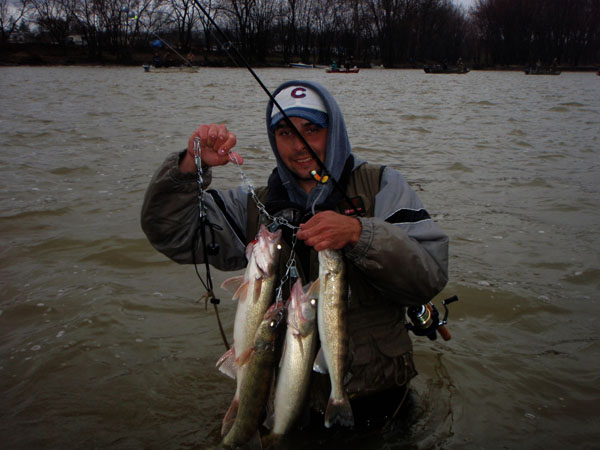Another spring season is quickly approaching and there is no better way to begin the open water season than to run with infinite amounts of fish during their seasonal spawning migrations. Back in April of 2009, I had one of my most enjoyable spring fishing experiences ever.
Joined by friends, Mike Goode, John Dyers, and Ohio resident Nate Tessler, I traveled 300 miles east from Chicago to Perrysburg, Ohio, where we fished the Maumee River for a long weekend.
The Maumee River is legendary and well known within the Great Lakes region as walleyes by the thousands migrate from Lake Erie into this river system to spawn. According to the Ohio Division of Wildlife, the annual walleye run up the Maumee River is one of the largest river migrations occurring amongst any freshwater sport fish east of the Mississippi River. For up to two months, anglers by the hundreds enjoy catching their daily walleye limits by fishing concentrated fish spawning sites shoulder-to-shoulder.
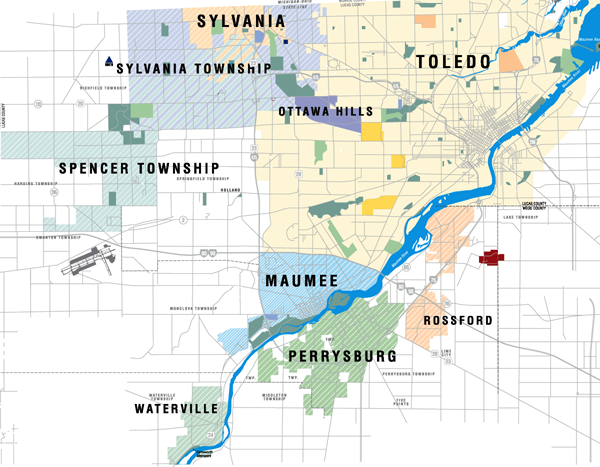
Fishing a few feet away from hundreds of other fishermen is intimidating. I was terrified at first and my participation on this trip was questionable. Despite these fears, I did not let them prevent me from enjoyment.
Privileged to experience this legendary run, I quickly learned that we don’t get anything like this in Illinois.
Beginning in March and lasting until early May, the Maumee River walleye run is driven by a number of factors that includes water temperature, river currents, and hours of daylight. Peak spawning occurs anytime from March through April when water temperatures are in the range of 42 to 55 degrees. However, best activity frequently occurs the last week of March through the first week of April.
Typical spawning habitat of the river is comprised of swift hard bottomed mid-river current runs with a composition of gravel and rock. Depths are usually shallow in the range of 3 to 6 feet. It is common for several dozen spawning male walleyes to be concentrated and relating to the same 50 foot stretch of bottom structure.
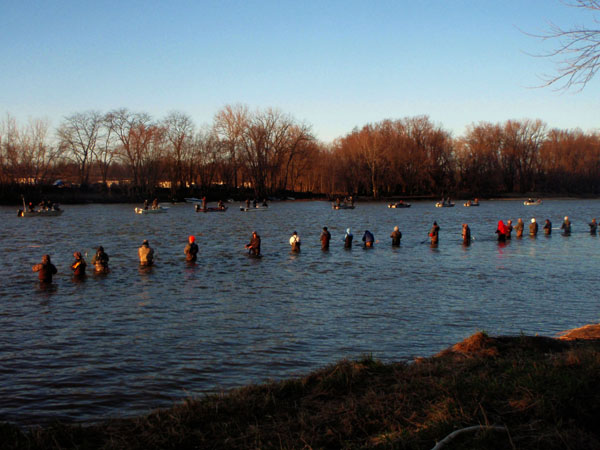
The majority of the walleyes that are present in the river to spawn are males, locally referred as “Jacks”. Running at an average length of 19 to 24 inches and weights of two to four pounds, the aggressive males eagerly take your jig in almost any situation. While females are sharing the waters with the more abundant Jacks, they tend to be less aggressive, their presence goes unnoticed, and their population numbers are low in comparison. Catching fish larger than 10 pounds is possible, but if caught, it is suggested to release the females as they replenish the system with future generations of fish, and enable future walleye runs to take place. This is the unwritten courtesy rule of the river.
This fantastic run of walleye is an excellent period of fishing for anglers who do not have access to boats and cannot fish Lake Erie. In order to get up close and personal with Maumee River walleyes, wading is generally the best way to fish the run.
What makes the walleye run unique is the special regulations and strict management set forth by the Ohio Division of Wildlife. First, nighttime fishing is banned from March 1st through May 1st. This allows for the migratory walleye to move into their spawning sites to lay eggs, unmolested. Second, the daily bag limit of six fish per day at 15 inches is reduced to just four fish during this two month period. Thanks to the heavy angling pressure, this reduced bag limit helps conserve the naturally-spawning fish populations. Third a hook size regulation is also in effect. It is unlawful for anglers to use a line with more than one single hook attached. This means no lures with treble hooks, or hook sizes larger than one-half inch from shank to point. Lastly, because of how concentrated the walleye numbers are during the run, some will be accidentally snagged with even a single hook. Consequently all snagged fish must be returned.
As previously noted with the hundreds of other fishermen I would be sharing the water with, I was also intimidated by these special regulations.
With all of these factors being included in the game plan, a typical day of fishing the run occurs from sunrise to sunset. Anglers by the dozens arrive daily at the river by dawn, reserving their spots by sunrise, then fishing and focusing their efforts on shallow current runs with hard bottom.
During my two days of fishing the run, I failed to catch my limit. However, friends and seasoned veterans of the run, John Dyers and Nate Tessler, scored limits on both days.
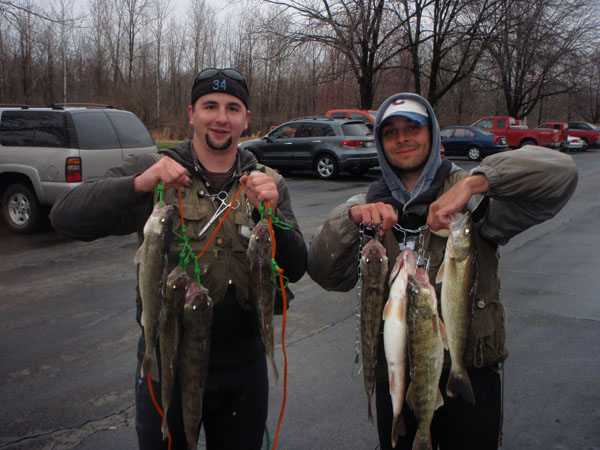
Fishing the walleye run requires a learning curve as the type of fishing experienced is far different than anything else you may ever come across. For example, I learned the stubborn way. Here on our northern Illinois rivers, I traditionally fish with lighter gear: Six and a half foot St. Croix medium action rods with size 20 Quantum Energy spinning reels spooled with 6 lb. copolymer line. My personal experience called for me to try my proven finesse methods first, before switching over to what actually works best for the run.
If you fish this run, forget about finesse. Power and strength will be needed.
For half the day on day 1, while witnessing Johnny and Nate catch their limits in less than four hours, I caught nothing by utilizing my light gear approach. Light bites, strong river currents, and poor rod strength led to futility and lack of fish on the stringer. It was after our lunch break when I realized that I had made a mistake by not choosing to fish with my much stronger 7 ft. medium heavy action rod with size 30 Quantum Energy reel spooled with 10 lb. copolymer line. Not planning to originally fish with this heavier rod and reel combination, I was at least smart enough to pack it in the car.
I was finally onto fish as soon as I made the switch over to the heavier gear during the afternoon hours.
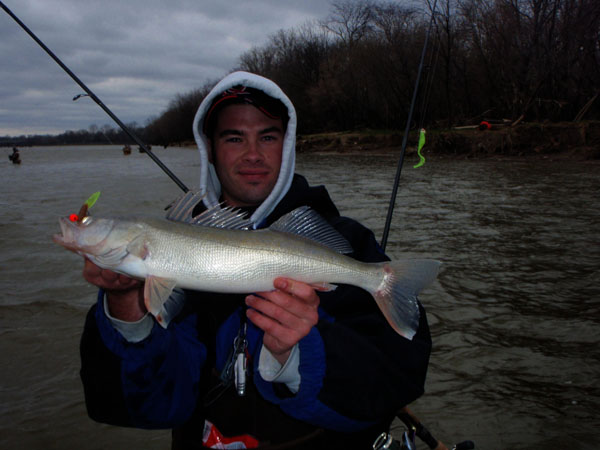
Due to the special angling regulations, approximately 100 percent of the anglers you will come across will be using a simple fishing approach. The best mode of angling is to present the fish a floating jig rig. This simple rig is like your typical Carolina rig used for bass fishing, consisting of the following components:
- 3/8 oz. sliding egg sinker (use heavier weight depending on the current)
- Barrel swivel
- 2 foot leader: 12 to 14 lb. fluorocarbon preferred. Pre-tie your leaders beforehand.
- Floating jig in bright colors tipped with fluorescent 3 inch twister tails.
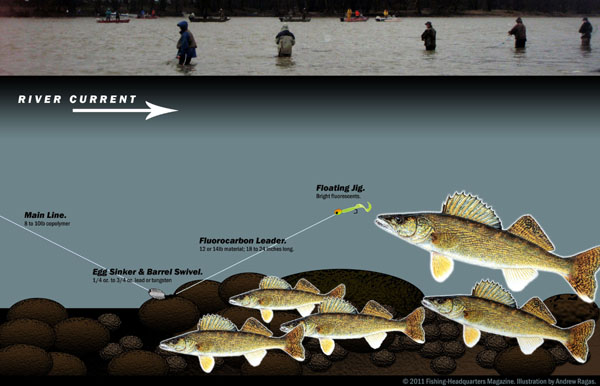
Due to its bottom hugging and floating capabilities, this rig ultimately enables you to present your bait longer in the water column and over the spawning sites before the current sweeps it away. Other than long casts and keeping up with the current which controls the presentation and retrieve, it requires very little physical effort.
Typical rods and reels used during the run range in lengths from 6 ½ to 7 ½ feet long. Standard rod actions are usually medium but I prefer a 7 foot medium heavy action or greater due to longer casting distance, fighting the current and powerful hook-sets. As far as line goes, 8 to 12 pound abrasion-resistant copolymers work exceptionally well.
Although I never caught my limit of walleyes (came up 1 fish short each day), I enjoyed a great time with friends, and was able to learn about this unique approach to fishing.
The Maumee River is a big river and must be respected like all other flowing bodies of water. Safety and knowledge of regulations should always be the highest priority. In addition, being polite and respectful of all the other anglers who will be sharing your fishing spot is necessary. You never know when borrowing your neighbor’s landing net may come in handy.
The river setting will be far from peaceful and quiet with the hordes of anglers that will be around. If abundant walleyes are on tap for your spring fishing schedule, there are 8 weeks during the season to accomplish it.
From the mouth of Lake Erie in Toledo, downstream 10 miles past the town of Perrysburg, the river is loaded with an abundance of access areas, fishing spots, and opportunities to catch daily limits.
Make reservations. This April marks my first return trip since 2009. Within reasonable distance from northern Illinois, there is no better place in the Midwest region to find walleye fishing as good as this.
